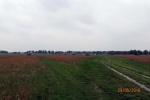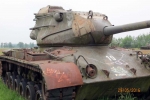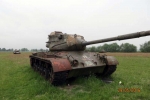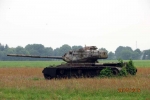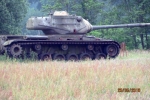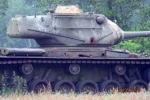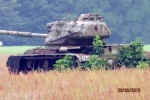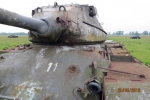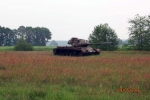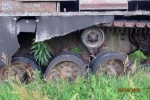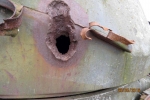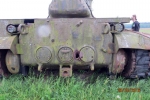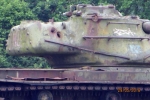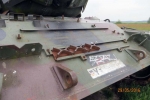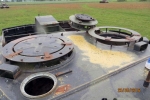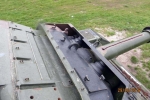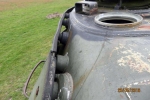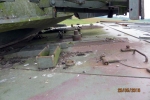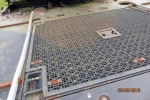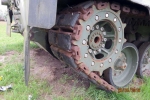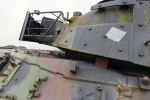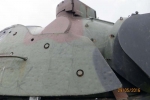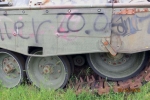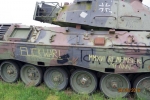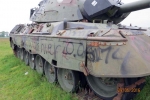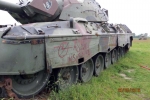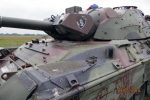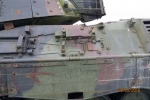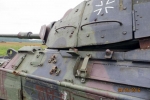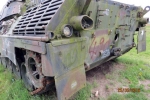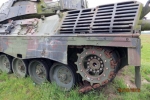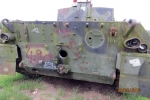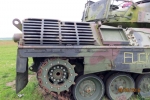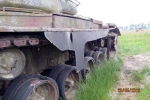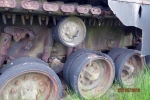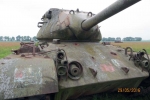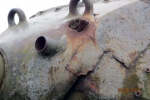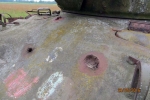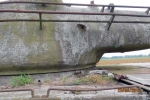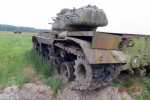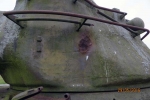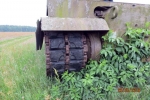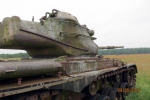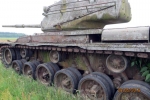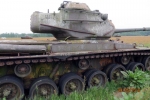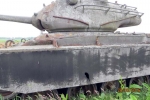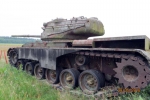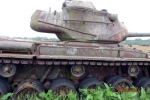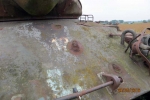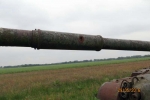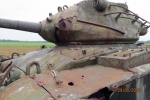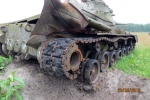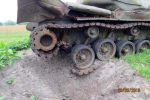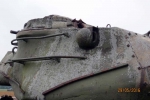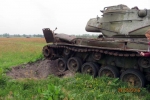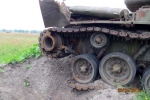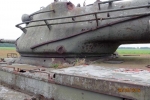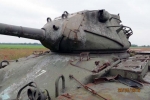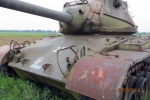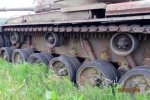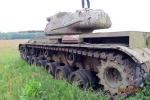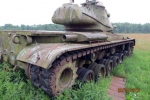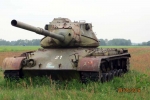1⁄1The Ravages of Time
17
Comments
If you are near to Lathen-Wahn and if you look very carefully through the mists of the surrounding countryside you may see a field of silent M47 and Leopard tanks sat silently in neat formation. Here are some photos of several M47 tanks with some hits and a Leopard 1A5. The tanks are standing on a shooting range near Lathen-Wahn at the WTD 91 in Meppen, Germany. The M47ís are from the Italian Army but Christian doesn't know anything of the history of the tanks. The Photos could be used as a reference for replicating some damage on models or painting.
Comments
It is interesting to note the level of rust and chipping on these tanks that have been sitting out in the elements, neglected, and shot at as range targets, for many (probably 40+ for the M47s) years. They do not exhibit the amount of rust and chipping that is portrayed using the latest, greatest weathering fads that are being seen as of late. Many modelers who follow these latest fads add more rust and chips to their supposedly "in-service" tanks than these display.
Go figure. Another example of why I don't subscribe to the latest weathering fads.
OCT 26, 2016 - 08:48 PM
While I agree some of the chipping/rusting done is to much these tanks are not a good example to cite in this case. These are peace time tanks that were used as range targets.
What I mean by peace time tank is this. The tank would not be used near as much or as harsh as a wartime tank. Thus would not show the wear and tear of a tank in combat. Also crews are forced to take better care of the tank in peacetime. How many cold war tankers would want the SGT Major on their butt for a beat up looking tank?
As far as them being range tanks, they have very little damage from their life on the range. One has to believe that they were not there long or the Germans can not shoot so well (just a little fun, do not flame me kind German folk)
So a well maintained lightly used tank that spent little time as a target would not be all chipped and rusted like a tank that spent weeks in combat. This being said I agree with you about some of the work I have seen. Most tanks did not last all the long being shot at in combat. I am a middle of the road guy, some chipping and rusting is ok but it can, and has been, over done.
OCT 26, 2016 - 09:32 PM
Still disagree. Vehicles are still maintained while in combat and they do not usually get chipped and rusted like the current fad is. I have been in/on armored vehicles in combat and peacetime for over 20 years of active duty and can attest to how vehicles are actually taken care of in both situations. They are not allowed to get as bad as the fad weathering makes them out to be, even in combat. That vehicle is your lifeline in combat and you keep it in very good working order. Rust and chipped down to the metal only makes stuff not work as designed, which is bad in combat.
OCT 26, 2016 - 10:04 PM
Still disagree. Vehicles are still maintained while in combat and they do not usually get chipped and rusted like the current fad is. I have been in/on armored vehicles in combat and peacetime for over 20 years of active duty and can attest to how vehicles are actually taken care of in both situations. They are not allowed to get as bad as the fad weathering makes them out to be, even in combat. That vehicle is your lifeline in combat and you keep it in very good working order. Rust and chipped down to the metal only makes stuff not work as designed, which is bad in combat. [/quote]
I agree with you Gino...its the applications of the vehicles in the field and the conditions they find themselves in from time to time. Having been a C-5 Flight Engineer over a dozen years gave me excellent opportunities to see how armor and aircraft both react to the elements. The modeling 'fad' of weathering does tend to get a bit overdone/overemphasized. The general rule of thumb for both aircraft and land targets: they have to be maintained to exceptional levels or they are no good to you when its comes time to 'participate' in a liberation party somewhere. Only in extreme and rare cases, like the days/weeks/months of battling forces of WW2, for example, would you find that extreme weathering opportunity. When the dispute is decided, the vehicles are repaired and retrofitted, thus returning the vehicles, and aircraft, to as near a pre-combat condition as humanly possible. For most of us in the U.S. military, rust/corrosion is your enemy and is dealt with accordingly and immediately (can't speak for other countries and/or 3rd world/banana republics however).
OCT 27, 2016 - 05:40 PM
I can not speak as any sort of authority on weathering, wear and tear on vehicles and over/under representing this in scale modeling.
I have read several accounts over the past few years concerning how the US armed forces approach the issue of maintenance in peace time and "in country" so to speak.
True enough, the quality of paint has improved a lot and has contributed to better vehicle appearances. PMCS is a way of life.
My experiences differ somewhat from that of John and Gino, respectively. I would say that close to half of the time, our vehicles looked like [auto-censored] and so did we. By the grace of God, great mechanics and PMCS, the vehicles worked better than the manufacturer(s) could have expected.
Cosmetic concerns, although important for a variety of reasons, had to take a tertiary place in the scheme of things....this was true down to the individual soldiers as well. Lots of kit that was not serviceable by the regs, yet, not easily replaced. Nothing macho or rebellious in this, just the fact of the matter.
Rhinos bent as if they had arthritis, fenders rolled up, mirrors knocked off, broken hoods, not to mention battle damage, frequently were not fixed. This included ballistic glass and "gouges" in ceramic armor. Yet, even compromised glass was kept as clean as possible until something could be done.
The allied logistics system provided us with what they could as soon as they could, however, it could not always be timely. Personally, I have never seen any issued touch up paint in theatre and we never lost a wink of precious sleep over it.
Based on what little I have seen of battles in Syria and Ukraine, it looks like a lot of worn exteriors on some modern equipment.
Respectfully,
Allen
OCT 28, 2016 - 04:59 AM
Interesting that they went to the effort to extend the M47's gun tubes with pipe. It also looks like they permantly closed the range to tank gunnery after a platoon went through.
OCT 28, 2016 - 08:33 AM
Hello Greg. I noticed that there were longer barrels and what looks like some sort of support brackets on the left rear of the M47's. You reckon that this was intended to make them look more like enemy vehicles?
Allen
OCT 28, 2016 - 09:12 AM
I an surprised that with all the vets around here no one it seems ever had range detail?
The sheet metal on the M47s is to cover the empty engine bays. It should also prevent spalling and splash. As anyone who shot at hard targets will tell you there can be quite a light show from ricochet. To keep the targets from rusting away one could put a sheet metal cover over any hallow parts and a rubber blanket which would also make an M47 look vaguely T-72-ish as well as help preserve the hard target.
If you notice on one the tubes are welded together to vaguely mimic a T-62 gun barrel. And through a sight an M47 turret in silhouette does look vaguely like the frying pan shape gunner's are trained to identify as a Soviet tango.
Anybody have pictures of the old "live" hard targets made from sheet metal and mounted on old M114 chassis? They also had approximations of the turret shape and easily recognized gun barrel configuration of Soviet tanks.
OCT 28, 2016 - 09:47 AM
Hello Stephen,
Interesting information that you have shared regarding your experience on range detail. I usually enjoyed it as it allowed us to see some things up close. I am not familiar with the safety measures you listed concerning ricochets.
I do have a number of photos of M41's, M47's and 114's from the ranges at Hohenfels in 1981. Lots of HEAT penetrations, but, the quality of the steel in the armor was impressive considering the number of impacts.
One particularly cool thing, at least to me, was seeing the warhead of an M47 Dragon round stuck in the left front turret/turret ring interface...a classic perfect shot!
Respectfully,
Allen
OCT 28, 2016 - 10:27 AM
Since the 1980s range safety increased. I know a lot of ranges in CONUS were cleared of hard targets and subcaliber devices were developed to save on firing big bullets.
Also it's hard to score an engagement with sparks flying everywhere. It could have been a near miss that would not have damaged a real target. Throwing metal on metal isn't cost effective at training gunners.
I don't see it in the pictures but were any battery terminals by the rubber sheet? Could be a thermal blanket to simulate a heat signature. Can't see old cold rusting metal in a thermal sight very well. It's the difference between a hunk of plywood and a deer.
OCT 28, 2016 - 11:39 AM
Copyright ©2021 by Christian Scheffer. Images and/or videos also by copyright holder unless otherwise noted. The views and opinions expressed herein are solely the views and opinions of the authors and/or contributors to this Web site and do not necessarily represent the views and/or opinions of Armorama, KitMaker Network, or Silver Star Enterrpises. All rights reserved. Originally published on: 2016-06-10 22:58:17. Unique Reads: 15596





